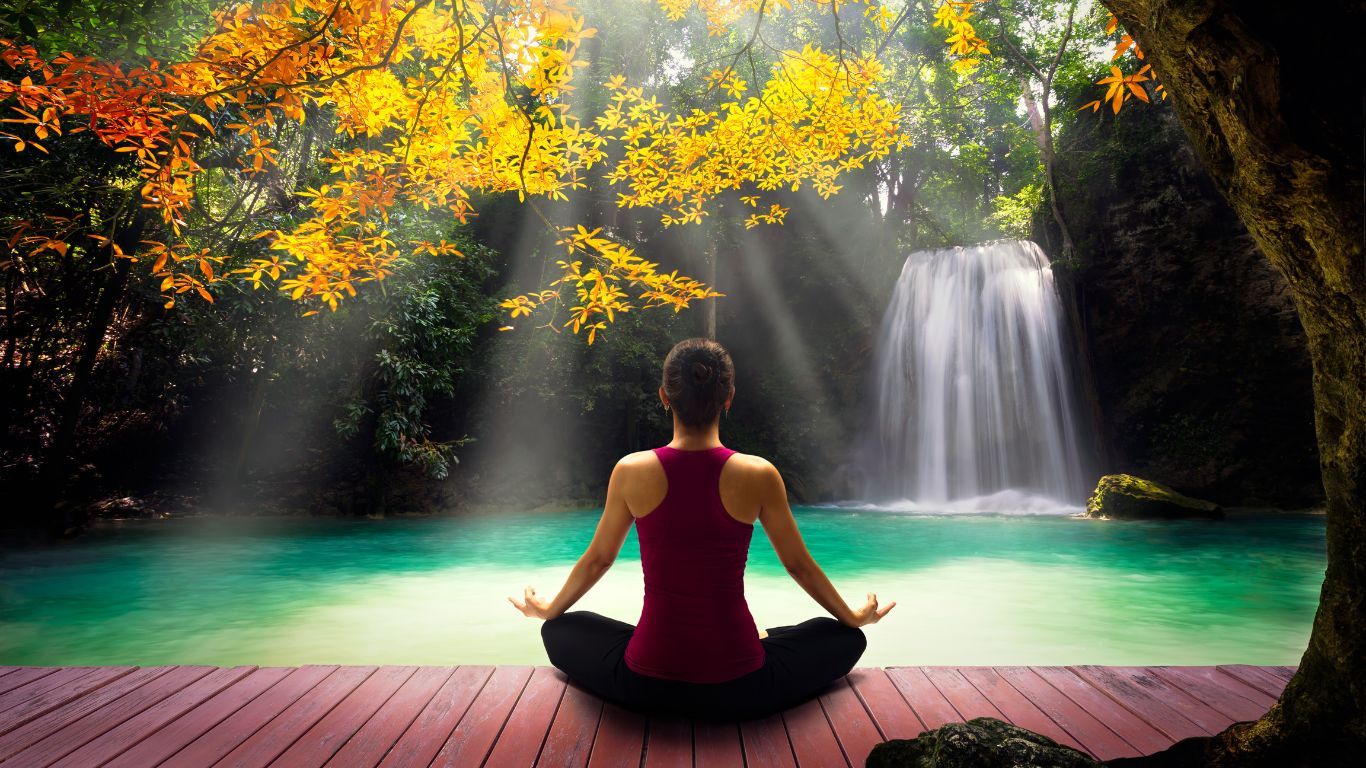
Is achieving inner peace possible? The concept of inner peace is one that has no rigidly defined meaning. We all have our own interpretation of what it means to have inner peace, and our own ideas of what leads to us obtaining it. Do we need to meditate deep in the mountains during a self-discovery retreat to find peace? Or go on a solo journey, depriving ourselves of anything save the bare essentials as Gautama Buddha himself once did?
Do we need to shed our egos, unburden ourselves of past trauma through therapy, or become more spiritual to find inner peace?
The process of finding inner peace is different for everyone.
However, inner work is always required in order to find inner peace.
While there’s no such thing as general step-by-step instructions on how to reach this level of bliss, there are guidelines that can help you make this internal shift. It’ll be a very different process for every unique individual. Finding or achieving inner peace is a growth journey that you can only be guided on to an extent. You can read some suggestions and forge your own path. In this overview, we’d like to take you through the process and act as your guide as you begin (or continue) your journey toward finding inner peace.
What Does it Mean to Have Inner Peace?
Many people define inner peace as a state of spiritual and physical calm, despite external stressors. When you find inner peace, it refers to the discovery of your inner calm contentment, no matter how difficult life becomes.
Many people imagine inner peace as the absence of intrusive, negative thoughts. Others imagine it as the ability to push away negativity and stress when it does float through the brain, and to view the world with optimism, and see past the obstacles before you.
We all go through challenges and conflicts in our lives, and inner peace is there to help guide us through it in a way that helps us be resilient, and prevents us from feeling overwhelmed or overly stressed.
Why is Finding Inner Peace Important?
A person who has done the inner work and achieved a state of inner peace will notice many benefits associated with this improved mental state. A person who has inner peace will be better able to combat negative emotions of stress, anxiety, grief, or overwhelm. Someone who has done the inner work of learning how to challenge negative thoughts, for example, is likely getting close to achieving inner peace because they’ve learned how to keep negative thoughts at bay.
Reaching a state of self-actualization is part of the process of finding inner peace as well.
Below are just some of the reasons why finding inside peace is important:
- Coping with life’s challenges becomes easier
- Better ability to handle the daily stressors of life
- More positive thoughts, and less negative thoughts
- Increased energy levels
- Improved emotional resilience
- Ability to see things more clearly and gaining better judgment
- Improved emotional maturity and improved emotional health
- Reduced anxiety
- Less negative self-talk
- Learning to be kinder and more compassionate towards others
- Learning to stop being as negatively impacted by society or by what others think
- Better able to process difficult emotions and express them
- Better sleep
Tips For Finding Inner Peace
If the concept of finding inner peace is important to you, the key is accepting that this growth journey is yours and yours alone, and it won’t be the same as anyone else’s journey. Nobody has the same demons as you, the same trauma as you, or the same hurdles to jump over as you. Every path is unique, and while you might share similarities with others, it will be your journey that you figure out for yourself.
There are many strategies you can try if you want to find that state of calm and contentment, and we are here to take you through the ones that many people have found useful when looking to achieve inner peace.

Spend Lots of Time in Nature
The practice of removing your shoes and allowing yourself to walk through the grass in bare feet somewhere quiet and amongst nature is one that contains a great deal of merit. It reconnects you with the earth, grounds you, and it is something that we don’t do enough.
Going on a scenic hike, a long walk, or even a camping trip can also help you reconnect with the natural world. We don’t take enough time away from the busyness of life to just take a deep breath and embrace the beauty of the world around us. Long-term exposure to nature can help to reduce feelings of stress and help you start to reconnect with the peaceful world.

Practice Meditation
Meditation has been shown to help on both a physical and spiritual level, clearing our minds and helping us to learn how to better process our thoughts. Mindfulness meditation can decrease anxiety as well as reduce feelings of depression and hopelessness.
Just 40-45 minutes of mindfulness meditation every day has been shown to bolster these effects and can help you on the path to achieving inner peace. You can do it at home, and yoga is also a form of meditation if this is more suited to you than traditional methods.
Learn to be Accountable
Accountability and being responsible for your actions is more to do with emotional maturity than anything else, but gaining emotional maturity is also part of obtaining inner peace. Emotional maturity is a sign of strength and growth, and when we are finally able to accept responsibility for the things we do, it opens us up to self-improvement.
Through accountability, you are able to take criticism and learn how to better yourself so that you can learn from your mistakes and prevent yourself from making them again.
Practice Gratitude
When we practice gratitude, it is remembering to be grateful for everything that we have in life (even the little things) and not complaining about what we are lacking. When we grow to appreciate all we have, we tend to find we have a higher sense of peace.
When we get in the habit of practicing gratitude and counting our blessings instead of counting our troubles, we are much more likely to notice a sense of inner peace.
Let Go of the Past
We cannot let our past mistakes or past trauma define us forever. It can be difficult to let the past go, especially when we are challenged by difficult memories, but it is not impossible. Many therapists specialize in helping people let go of the past. We cannot let the past prevent us from growing as a person and becoming our best selves.
Let go of regrets, and accept that you will make mistakes in the future, learn to hope again, and remember that every error you made in the past has served a purpose, taught you something, and helped you to grow into the beautiful person you are becoming.
Practice Acceptance
Quite simply, we need to accept that we have problems in life and that there are always going to be challenges to face. The sooner we learn how to deal with them, the easier it becomes to accept that things will not always be this way.
Self-acceptance involves knowing who you are, and owning your flaws, while normalizing having flaws. This is all part of getting to know yourself better, To get a better sense of your strengths and weaknesses and get to know yourself better, you could read 500 reports about yourself after taking an at-home DNA test. Love and accept yourself, including flaws.
Have Faith by Trusting in the Universe
Finding inner peace also involves having faith that good things are coming. Trust in the universe. It’s easier to be at peace mentally even when things are bad, if you have faith that it will get better. A positive mindset is key to achieving inner peace.
Learn to Love Yourself
We have to look inside ourselves and realize our own worth. Without self-care, self-love and self-acceptance, we will never truly achieve peace. You need to learn how to have a healthy relationship with yourself so that you can care for yourself on a physical, emotional, mental, and spiritual level.
Not only that, but a healthy relationship with yourself promotes healthier relationships with others and with the world around you.
The Psychology Behind the Mental State of Inner Peace
The question that remains is if there is a deeper psychological meaning behind the concept of inner peace. Psychology and spirituality often find themselves crossing when inner peace is discussed, and inner peace is one of those notions that finds itself in this same predicament.
Meditation is a practice that is often encouraged by experts in the psychology field, and when they refer to inner peace, it is referenced as a battle to control the external. Our peace is impacted by our own internal thought processes as well as the external events of the world around us.
Everything that we expose ourselves to has the ability to influence the way we internally think and feel. From a psychological standpoint, inner peace is learning how to control our reaction to these external stimuli – shielding ourselves from being negatively impacted, so that we can protect our mental health.
To Conclude
Achieving inner peace is a self-development journey that can take months or even years to complete. It is one that requires patience and inner work to better yourself, so that you can finally accept and be content with who you are.
It’s not always going to be easy, and there will be plenty of challenges for you to face along the way. However, with the help of this overview, you should be well on the way to carving your own path and reaching those levels of emotional maturity and emotional wellness.
References:
Manhatten CBT, How Long Should You Meditate for?: https://www.manhattancbt.com/archives/309/how-long-should-you-meditate/
Psychology Today, The Journey Toward Inner Peace: https://www.psychologytoday.com/gb/blog/meditation-modern-life/202102/the-journey-toward-inner-peace






